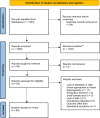Exploring Heterogeneity in perinatal depression: a comprehensive review
- PMID: 37667216
- PMCID: PMC10478465
- DOI: 10.1186/s12888-023-05121-z
Exploring Heterogeneity in perinatal depression: a comprehensive review
Abstract
Perinatal depression (PND) is a significant contributor to maternal morbidity globally. Recognized as a major cause of poor infant development, epidemiological and interventional research on it has increased over the last decade. Recently, studies have pointed out that PND is a heterogeneous condition, with variability in its phenotypes, rather than a homogenous latent entity and a concrete diagnosis, as previously conceptualized in psychometric literature and diagnostic systems. Therefore, it is pertinent that researchers recognize this to progress in elucidating its aetiology and developing efficacious interventions.This systematic review is conducted in accordance with the Meta-analysis of observational studies in epidemiology (MOOSE). It aims to provide an updated and comprehensive account of research on heterogeneity in phenotypes of PND and its implications in research, public health, and clinical practice. It provides a synthesis and quality assessment of studies reporting heterogeneity in PND using cutting-edge statistical techniques and machine learning algorithms. After reporting the phenotypes of PND, based on heterogeneous trajectories and symptom profiles, it also elucidates the risk factors associated with severe forms of PND, followed by robust evidence for adverse child outcomes. Furthermore, recommendations are made to improve public health and clinical practice in screening, diagnosis, and treatment of PND.
Keywords: Heterogeneity; Perinatal depression; Phenotypes; Postnatal depression; Postpartum depression; Trajectories.
© 2023. BioMed Central Ltd., part of Springer Nature.
Conflict of interest statement
The authors report no declarations of interest. Dr. Ahmed Waqas serves BMC Psychiatry as an associate editor; however, he was not involved in the peer review process for this manuscript.
Figures
References
Publication types
MeSH terms
LinkOut - more resources
Full Text Sources
Medical




